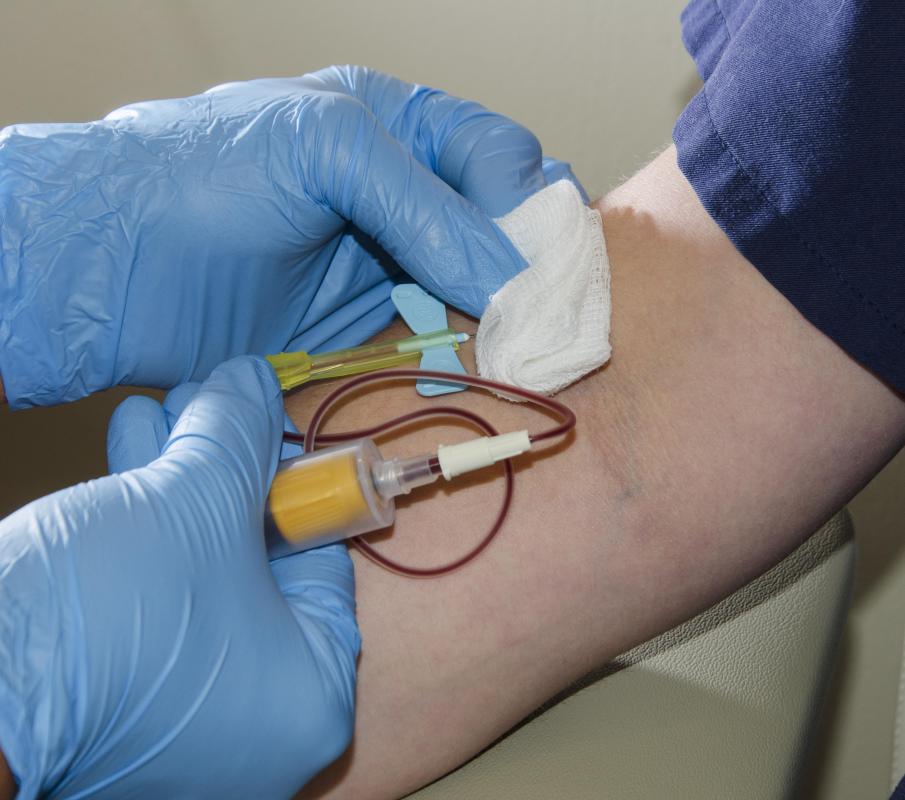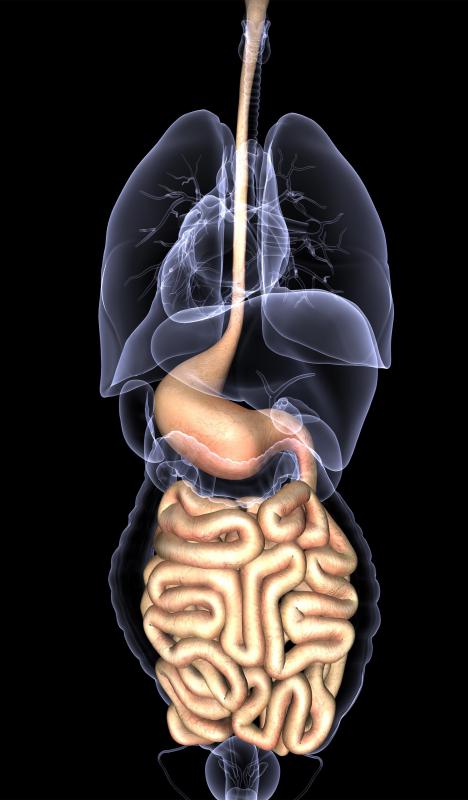At TheHealthBoard, we're committed to delivering accurate, trustworthy information. Our expert-authored content is rigorously fact-checked and sourced from credible authorities. Discover how we uphold the highest standards in providing you with reliable knowledge.
What Are the Vancomycin Peak and Trough?
The vancomycin peak and trough represent two extremes in terms of the levels of concentration of this antibiotic in a patient's bloodstream. At the peak, large amounts are circulating, and at the trough, the levels fall very low. Doctors must time dosing with the goal of keeping levels consistent by delivering medication before concentrations reach a trough. For some patients, a doctor may recommend regular monitoring during vancomycin therapy to keep track of levels and adjust doses and timing if necessary.
Vancomycin is a very aggressive antibiotic available in the form of an intravenous injection for treating a number of infections. There are some toxicity concerns with this medication and it is not a first choice treatment. While on vancomycin, a patient may need to stay in the hospital to receive supportive care for an infection, although sometimes it is possible to get injections at home or to receive them on an outpatient basis. It is also important to make sure the infection responds to treatment, and a doctor may need to check on vancomycin peak and trough levels.

Typically, the medication reaches peak concentration between one and two hours after administration. Depending on the size of the dose, the patient's general health, and other factors, the timing of the trough may vary. A doctor can request a peak reading after administration and check back to see when the patient hits the trough. The health care provider can adjust the timing of future doses to make sure the levels rise before bottoming out, keeping an even amount of medication in the bloodstream.

For some patients on vancomycin, there is a risk of liver or kidney damage. A doctor may need to take vancomycin peak and trough levels to see if a patient has dangerously high levels that might precede organ damage. If the patient's blood reveals high concentrations, the doctor can lower the dose and adjust the timing to address the issue. The goal is to prevent damage by being proactive with medication dosing, keeping the patient as safe as possible during a course of therapy.

A hospital lab can analyze blood to check for vancomycin peak and trough levels at a request from a physician. The doctor may write an order in the patient's chart for a nurse to take regular samples and send them to the lab for analysis. With some patients, only a single set of readings is necessary to allow the doctor to perfect the timing of the doses. Other patients may require regular measurements because of concerns about side effects and toxicity.
What Is Vancomycin?

Vancomycin is a glycopeptide antibiotic that is typically used to treat the inflammation of a person's intestine that is caused by a bacterial infection such as Clostridium difficile, which is commonly known as "C.diff". Unlike other systemic antibiotics that affect a person's entire body, vancomycin does not work outside of the digestive system.
How Do I Know if Vancomycin is Working?

Vancomycin works in your intestines and is not effective for the common cold, flu, or other respiratory infections. It may be difficult to tell if vancomycin is working or if you are experiencing side effects from the treatment. Below are a few signs that your treatment is effective:
- Symptoms such as diarrhea and cramping are stopping or improving
- Your fever has broken
- Your bloodwork is returning to normal (you may have been told you have an elevated white blood cell count and other abnormalities)
- You are no longer feeling dehydrated due to loss of fluids caused by diarrhea
- You are no longer experiencing a rapid heart rate or palpitations
Can I Stop Vancomycin if I Feel Better?
Not before finishing all of your pills. It's very important to complete the entire regimen (whether the medicine has been prescribed for seven to 10 days) to ensure that the infection has been fully eradicated from your body. Even if you feel great on day six, don't stop taking your vancomycin before speaking to your doctor.
How Long Does Vancomycin Stay in Your System?
Vancomycin has a half-life of four to six hours, which means that if you are healthy overall, this drug will stay in your system for a few days after you finish your final dose. If you have kidney problems or you only have one kidney, it will take longer for your body to break down and get rid of the vancomycin. If you have more questions about vancomycin treatment or you're concerned about taking this medicine due to another chronic condition you have, don't be afraid to ask your doctor or medical professional for guidance.
How Long Will I Have To Take Vancomycin?
This depends on the condition you're being treated for as well as the administration method. If you're taking vancomycin capsules or tablets, you will likely have to take it three to four times a day for up to 10 days. It's important to take your medicine exactly as directed. You don't need to take it with food, but doing so may prevent stomach upset.
Side Effects of Vancomycin Treatment
Because vancomycin mainly affects the intestines, the most commonly reported side effect is stomach upset. You may notice gas, diarrhea, or feel bloated during this treatment. Some patients have no side effects at all. If you take intravenous vancomycin (administered at a hospital or outpatient clinic), you may experience more side effects than if you took tablets or another preparation. These effects can include the following signs and symptoms:
- Low blood pressure
- Kidney toxicity
- Muscle spasms
- Allergic reactions such as hives, itching, or anaphylaxis
- Chills and fever
- Bruising at the IV insertion site
Administering the vancomycin IV slowly can help prevent a serious reaction. As always, if you notice severe symptoms after taking this medication such as dizziness, trouble breathing, or nausea that is so bad that you can't keep food down, please seek out emergency care. If you are pregnant, have inflammatory bowel disease, or have had a bad reaction to an antibiotic in the past, be sure to tell your doctor or medical team before receiving an IV treatment or agreeing to take vancomycin.
What Are the Vancomycin Peak and Trough Guidelines?
When referring to a drug administered to a patient, peak and trough levels indicate the lowest serum concentration in the patient's bloodstream (the trough) and the highest (the peak). It is very important for medical professionals to monitor these levels to ensure patient safety, and when the patient takes a drug with high toxicity potential, it is crucial to keep the serum levels within a specific range. Vancomycin's trough level should be kept at around five to 15 mcg/mL, while the peak level should not exceed 20-40 mcg/mL.
Is Vancomycin an Effective Treatment?
Vancomycin is one of the top choices of antibiotics to treat a patient's serious or life-threatening infection caused by gram-positive bacteria. Sometimes, bacteria are not killed by antibiotics that are less potent. If you have to take vancomycin, maintain communication with your medical team throughout the process and rest assured that it will likely eradicate your infection.
AS FEATURED ON:
AS FEATURED ON:















Discussion Comments
Sure it is scary. The post says that vancomycin is an "aggressive antibiotic". So, I am assuming whatever the intravenous medication is designed to treat, is also aggressive and dangerous. Trained health professionals are adept at vancomycin level monitoring, so patients have to weigh the risk to benefits ratio. I would bet, that the benefits of killing the ailment, far outweigh the dangers associated with the treatment.
The treatment, vancomycin dosing has to be so precise and vancomycin side effects; "toxicity concerns", liver or kidney damage, is scary to me.
Post your comments